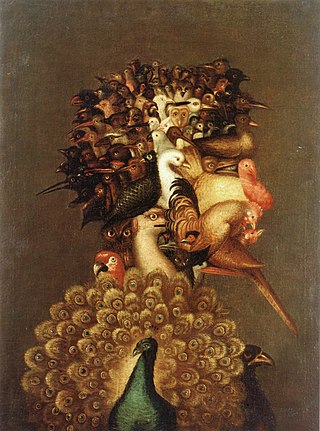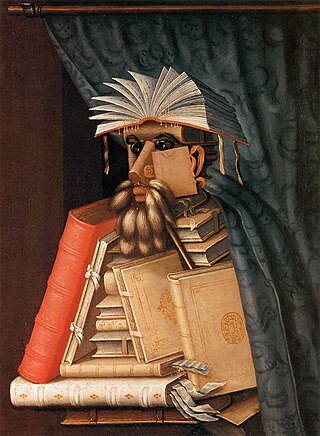
Mannerism is a style in European art that emerged in the later years of the Italian High Renaissance around 1520, spreading by about 1530 and lasting until about the end of the 16th century in Italy, when the Baroque style largely replaced it. Northern Mannerism continued into the early 17th century.

Rudolf II was Holy Roman Emperor (1576–1612), King of Hungary and Croatia, King of Bohemia (1575–1608/1611) and Archduke of Austria (1576–1608). He was a member of the House of Habsburg.

In Roman mythology, Vertumnus is the god of seasons, change and plant growth, as well as gardens and fruit trees. He could change his form at will; using this power, according to Ovid's Metamorphoses (xiv), he tricked Pomona into talking to him by disguising himself as an old woman and gaining entry to her orchard, then using a narrative warning of the dangers of rejecting a suitor to seduce her. The tale of Vertumnus and Pomona has been called "the first exclusively Latin tale."

Hans von Aachen was a German painter who was one of the leading representatives of Northern Mannerism.

Skokloster Castle is a Swedish Baroque castle built between 1654 and 1676 by Carl Gustaf Wrangel, located on a peninsula of Lake Mälaren between Stockholm and Uppsala. It became a state museum in the 1970s and displays collections of paintings, furniture, textiles and tableware as well as books and weapons that amount to 20,000 items.

Bartholomeus Spranger or Bartholomaeus Spranger was a Flemish painter, draughtsman, sculptor, and designer of prints. Working in Prague as a court artist for the Holy Roman emperor Rudolf II, he responded to his patron's aesthetic preferences by developing a version of the extreme style which has become known as Northern Mannerism. This style stressed sensuality, which was expressed in smoothly modeled, elongated figures arranged in elegant poses, often including a nude woman seen from behind. Spranger's unique style combining elements of Netherlandish painting and Italian influences, in particular the Roman Mannerists, had an important influence on other artists in Prague and beyond as his paintings were disseminated widely through prints.

The Jurist, also known as The Lawyer, is an oil-on-canvas painting by Italian artist Giuseppe Arcimboldo, painted in 1566.

Ambras Castle is a Renaissance castle and palace located in the hills above Innsbruck, Austria. Ambras Castle is 632 metres (2,073 ft) above sea level. Considered one of the most popular tourist attractions of the Tyrol, Ambras Castle was built in the 16th century on the spot of an earlier 10th-century castle, which became the seat of power for the Counts of Andechs. The cultural and historical importance of the castle is closely connected with Archduke Ferdinand II (1529–1595) and served as his family's residence from 1567 to 1595. Ferdinand was one of history's most prominent collectors of art. The princely sovereign of Tyrol, son of Emperor Ferdinand I, ordered that the medieval fortress at Ambras be turned into a Renaissance castle as a gift for his wife Philippine Welser. The cultured humanist from the House of Habsburg accommodated his world-famous collections in a museum: the collections, still in the Lower Castle built specifically for that museum's purpose, make Castle Ambras Innsbruck one of the oldest museums in the world.

People often see hidden faces in things. Depending on the circumstances, this is referred to as pareidolia, the perception or recognition of a specific pattern or form in something essentially different. It is thus also a kind of optical illusion. When an artist notices that two different things have a similar appearance, and draws or paints a picture making this similarity evident, they make images with double meanings. Many of these images are hidden faces or hidden skulls.

Northern Mannerism is the form of Mannerism found in the visual arts north of the Alps in the 16th and early 17th centuries. Styles largely derived from Italian Mannerism were found in the Netherlands and elsewhere from around the mid-century, especially Mannerist ornament in architecture; this article concentrates on those times and places where Northern Mannerism generated its most original and distinctive work.

Aegidius Sadeler or Aegidius Sadeler II (1570–1629) was a Flemish engraver who was principally active at the Prague court of Rudolf II, Holy Roman Emperor and his successors.

The Chamber of Art and Wonders is a cabinet of curiosities created in the 16th century by Ferdinand II, Archduke of Austria and located in Innsbruck, Austria. Ferdinand II was the sovereign ruler of the County of Tyrol and Further Austria, and a prominent collector of art. He built this museum specifically to showcase his collections.

Giuseppe Arcimboldo was an Italian painter best known for creating imaginative portrait heads made entirely of objects such as fruits, vegetables, flowers, fish and books.

The Four Elements is a series of four oil paintings by the Italian artist Giuseppe Arcimboldo which were created in 1566, during the Renaissance, for Maximilian II, Holy Roman Emperor. The paintings depict human faces in profile made up from different animals or objects. Air is represented by birds, Fire by burning wood and cannons, Earth by land animals and Water by marine creatures. The series attempts to express the creation of harmony from chaos by the careful arrangement of the wild animals to form portraits whilst also praising Maximilian by suggesting that he is a ruler who controls even the four primal elements.

The Librarian is an oil-on-canvas painting by the Italian artist Giuseppe Arcimboldo in the collection of Skokloster Castle in Sweden. It is thought to be a portrait of Wolfgang Lazius, a humanist and historian who served Holy Roman Emperors of the House of Habsburg.
František Makeš is a Swedish artist, scientist and chemist, speciaslising in the conservation of art objects.

The Seasons or The Four Seasons is a set of four paintings produced in 1563, 1572 and 1573 by the Italian artist Giuseppe Arcimboldo. He offered the set to Maximilian II, Holy Roman Emperor in 1569, accompanying The Four Elements. Each shows a profile portrait made up of fruit, vegetables and plants relating to the relevant season. The set was accompanied by a poem by Giovanni Battista Fonteo (1546–1580) explaining their allegorical meaning.
Proto-Surrealism is a term used for Surrealism avant-la-lettre. It is the study of various forms of art, literature, and other mediums that correspond to, reference, or share similarities to the 20th-century art movement known as Surrealism. This definition is considered a controversial topic, with many debating the suitability of the term surrealism to describe these bodies of work and instead opting to use the term Fantastique or Fantastic Art.

Self-Portrait is a small oil-on-panel painting by the Italian artist Sofonisba Anguissola, signed and dated 1554 on the open book held by the artist. The portrait is now in the Kunsthistorisches Museum in Vienna.
Food art is a type of art that depicts food, drink or edible objects as the medium or subject matter of an artistic work to create an attractive visual display or provide social critique. It can be presented in two-dimensional or three-dimensional format, like painting or sculpture. Food art can also incorporate food as a medium.

















